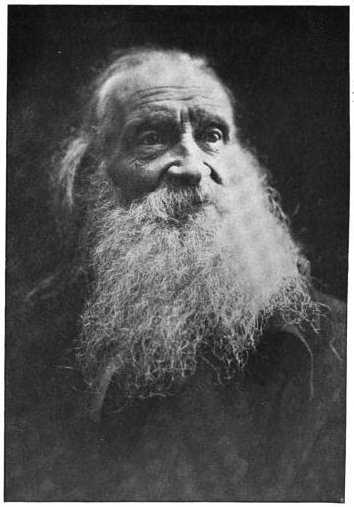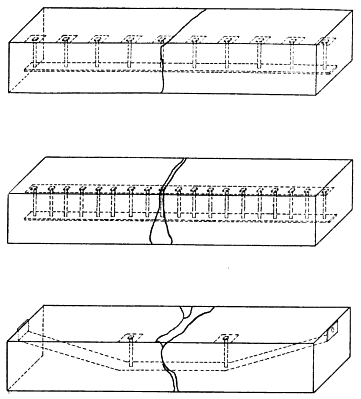|
Up: Hyatt |
Thaddeus Hyatt Biography · Prof. Charles M. Spofford · February 19, 1913 Home > Prism Glass > United States > Hyatt > Freedom's Champion |
Articles: 11 of 11 |
|
Up: Hyatt |
Thaddeus Hyatt Biography · Prof. Charles M. Spofford · February 19, 1913 Home > Prism Glass > United States > Hyatt > Freedom's Champion |
Articles: 11 of 11 |
|
AND USER OF REINFORCED CONCRETE. By Prof. Charles M. Spofford, Member Boston Society Of Civil Engineers. [Read before the Society, February 19, 1913.] It is the purpose of this paper to give
a brief description of an American, Mr. Thaddeus Hyatt, who was one of
the earliest users of reinforced concrete, and who has not received as
yet the credit to which the writer believes him entitled.
Mr. Hyatt was a lawyer by education but an
inventor by nature. He was born in New Jersey in 1816, but lived most
of his life in New York City and London. One of his early inventions
was an illuminated sidewalk grating, the use of which first made it
possible to light the basement areas under the sidewalks of New York
City, thereby adding materially to property values. The Hyatt grating is
still made. The manufacture of these gratings soon proved sufficiently
profitable to enable Mr. Hyatt to leave the conduct of this business in
the hands of his managers and devote his own time and considerable money
to experiments and study along other lines. Among many subjects which had
long interested him was fireproof construction, he having early recognized
that the unprotected iron then employed in so-called fireproof buildings
was by no means fireproof. His use of Portland cement in conjunction
with iron in the manufacture of gratings convinced him of the value of a
combination of these materials both with respect to strength and
resistance to fire, and he was led to experiment very extensively with
such a combination.  Thaddeus Hyatt In 1877 he published privately a book
giving his views upon fireproof construction, together with results of
tests of various combinations of iron and concrete. The title of this
book is "An Account of Some Experiments with Portland Cement Concrete
Combined with Iron as a Building Material with Reference to Economy
in Construction and for Security against Fire in the Making of Roofs,
Floors and Walking Surfaces."
Among the subjects which he investigated
were the following:
The fireproof qualities of floors made of
Portland cement and iron. The heat conduction power of concrete. The
coefficient of elasticity of concrete. The strength of concrete beams
with iron rods and bars embedded therein. The effect of quenching red
hot concrete in cold water. The relative economy of solid floors of
concrete with tension steel embedded therein as compared with floors
composed of concrete and rolled beams.
The beam tests were made by Kirkaldy,
the well-known testing engineer, and are very interesting. The figures
accompanying this paper show some of many different combinations which
he tested, and serve to indicate the wide scope of his experiments.  Specimens of Reinforced Concrete Beams Tested for Thaddeus Hyatt From the results of his studies and tests,
Mr. Hyatt drew the following conclusions:
Hyatt was so firmly convinced by these
studies of the desirable qualities of reinforced concrete that he
constructed a building on Farrington Road, London, in which he used
much of this material. To convince others of its fireproof character,
he built a fire in it without causing material damage. The building is
still in use and has been visited by the writer.
A search through the records of the United
States Patent Office shows that he was granted one patent of broad
character covering the use of combinations of concrete and metal. This
patent, No. 206112, was described as follows by the United States Patent
Office Gazette of July 16, 1878.
The following portion of the original claim
made by Hyatt is of particular interest as indicating the origin of the
modern deformed bar, and in showing his knowledge of the importance of
the shearing stresses in a reinforced concrete beam.
This brief sketch would be incomplete were
no mention to be made of Mr. Hyatt's notable activity in lines distinct
from those we have described. During the years preceding the Civil War
he was active upon the anti-slavery side, and spent time and money with
great liberality to prevent the extension of slavery into Kansas. During
the heated contest which arose over this question he was continually
engaged in planning public meetings and in traveling back and forth
between Kansas and New York. He himself made but few public speeches,
but was content with the organization of these meetings and the defraying
of the expenses. His interest in this subject brought him into intimate
relationship with John Brown, and after the Harper's Ferry incident he
was called before the United States Senate to testify. This he absolutely
refused to do; consequently he was imprisoned for thirteen and one-half
weeks in the Old Capitol Prison in Washington. Undisturbed by this, he
made himself as comfortable as possible, invited his friends to visit
him, and continued his campaign against the extension of slavery by the
organization of more meetings and by vigorous newspaper articles. His
imprisonment was not long continued, as the pro-slavery senators found
it of little avail.
At a later date, soon after Lincoln's
election, the famine in Kansas gave him another opportunity to show
his public-spirited nature. The state was nearly exhausted, but through
his personal efforts a relief committee was appointed, through whom a
fund of $1,000,000 cash was raised, in addition to many other gifts,
the proper distribution of which he directed personally, and so wisely
that the state was soon in a prosperous condition again. His unselfish
devotion to the welfare of the state was widely recognized, and it is
related that a prominent lawyer, upon meeting him for the first time,
exclaimed, " Mr. Hyatt, the people of Kansas should erect a statue of
gold to your memory!"
His death occurred in 1901, at the age of
eighty-five. More fortunate than many, he lived to see the widespread
adoption of his system of fireproof construction, the complete extinction
of slavery and the rise of Kansas to a high position among the other
states in wealth and importance.
[NOTE.—Discussion of this paper is invited, to be received by Fred. Brooks, Secretary, 31 Milk Street, Boston, by June 15, 1913, for publication in a subsequent number of the JOURNAL.] |